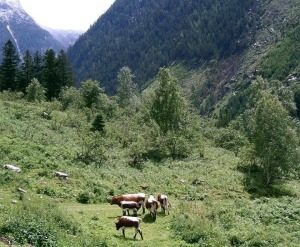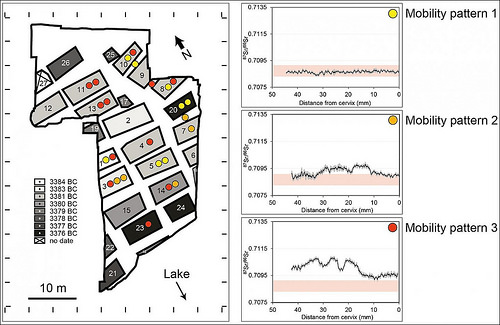
PLOS—Analysis* of strontium isotopes in teeth from Neolithic cattle suggest that early Europeans used different specialized herding strategies, according to a study published July 26, 2017 in the open-access journal PLOS ONE by Claudia Gerling from University of Basel, Basel, Switzerland, and colleagues.
Over the course of the Neolithic, secondary products from cattle such as milk, manure and animal power became more important. This led to larger herds, and the increased demand for grazing resources could have led to herding strategies that took advantage of grazing grounds away from the permanent settlement. However, until now there was little direct evidence for prehistoric cattle mobility.
To reconstruct cattle mobility and infer herding management, the researchers analyzed strontium isotopes in 39 molars from 25 cattle in a Neolithic settlement in what is now Switzerland. The settlement, which was occupied for 15 years, had 27 houses and the teeth could be assigned to 12 of them. Strontium signatures reflect local soil and plants, and can vary over relatively short distances.
The researchers found that the cattle molars had three strontium patterns, which likely reflected different herding strategies. The first pattern was consistent with the local strontium baseline, suggesting local cattle herding; the second pattern was a mix of local and non-local strontium signatures, suggesting seasonal movement; and the third was mostly non-local strontium signatures, suggesting year-round herding away from the site.
In addition, the researchers found that these three herding strategies were not uniformly represented in various areas of the settlement. This suggests differential access to the most favorable grazing grounds, which could have contributed to social inequalities between groups or households. Consequently, say the researchers, the increasing importance of cattle may have been a starting point for the socioeconomic differentiation that later became widespread during the European Bronze Age.
______________________________________
Cattle mobility patterns at the Neolithic wetland site of Arbon Bleiche 3. Settlement plan with reconstructed houses and distribution of cattle mobility patterns (MP) 1-3. Credit: Gerling et al (2017)
___________________________________________________
Article Source: PLOS One news release
___________________________________________________
*Gerling C, Doppler T, Heyd V, Knipper C, Kuhn T, Lehmann MF, et al. (2017) High-resolution isotopic evidence of specialised cattle herding in the European Neolithic. PLoS ONE12(7): e0180164. https://doi.org/10.1371/journal.pone.0180164
___________________________________________________
Receive 30 days free access to the popular new CuriosityStream lineup of documentaries on science, history, nature, and technology as a new Popular Archaeology premium subscriber.
___________________________________________
Travel and learn with Far Horizons.
____________________________________________
This richly illustrated issue includes the following stories: Recent findings shedding new light on the whereabouts of the remains of Philip of Macedon, father of Alexander the Great; how an archaeologist-sculptor is bringing bones of the dead back to life; archaeologists uncovering town life at the dawn of civilization; an exclusive interview with internationally acclaimed archaeologist James M. Adovasio about what makes the Meadowcroft Rockshelter prominent in the ongoing search for the first Americans; what archaeologists are finding at the site of the ancient city of Gath, the home town of the biblical Philistine giant, Goliath; and how scientists are redrawing the picture of human evolution in Europe. Find it on Amazon.com.








